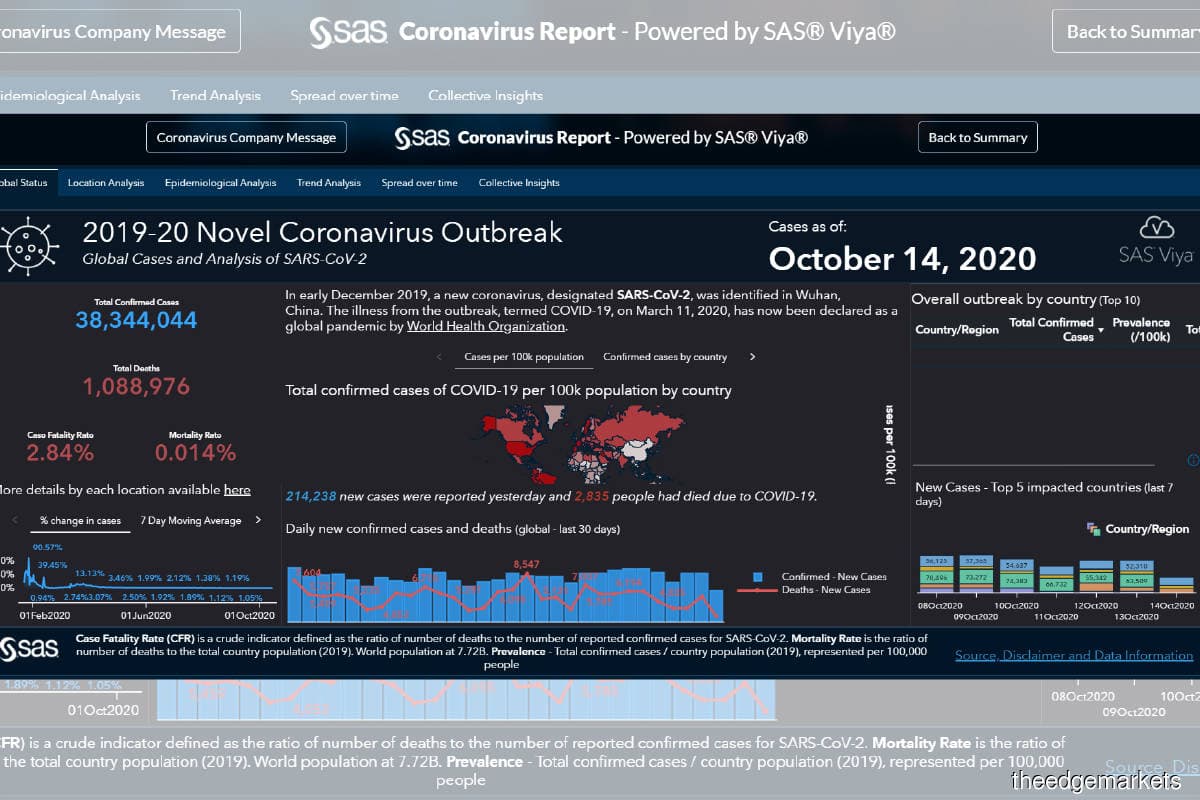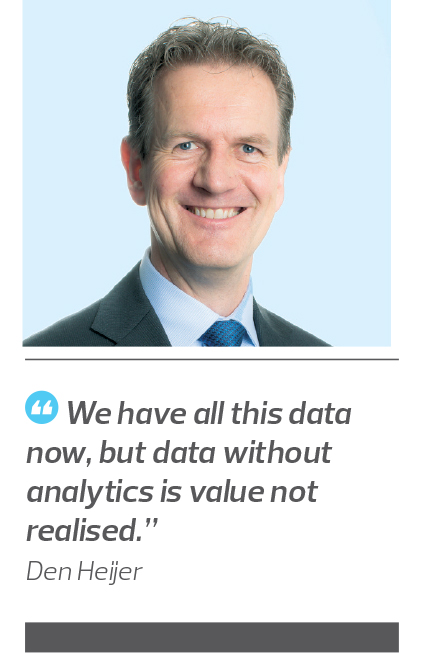
This article first appeared in Digital Edge, The Edge Malaysia Weekly on October 26, 2020 - November 1, 2020
Earlier this year, Remco den Heijer, vice-president of Asean at SAS Institute Inc, realised that someone had committed fraud with his credit card. While he was able to contact the bank and clear up the issue, he realised that this seemingly isolated incident was a symptom of a larger problem faced by financial institutions.
“Many banks have been fighting the symptoms [by helping customers recover lost funds] and not the underlying cause. They could actually use advanced analytics to detect anomalies in transaction patterns, and immediately take action,” says den Heijer.
The more quickly the banks react, the more likely the stolen funds can be recovered from the perpetrators, he adds.
“The banks can follow simple rules in analytics to detect anomalies or use predictive analytic models that are more sophisticated to find out [about] any potential fraudulent transactions before their clients do.”
This is an example of how advanced analytics can help businesses analyse patterns and predict trends, says den Heijer, who has worked for the global advanced data analytics company for nearly two decades.
It is important for businesses to adopt advanced analytics because it can help them transform processes to become more effective and also help them save costs. For instance, banks that use analytics to detect fraud early could avoid having to compensate clients who are victims of credit card fraud, says den Heijer.
“They can then sell credit cards with lower charges and become more competitive because they don’t have to take a hit from fraudulent charges. If they can stop fraud from happening, they can even cut down the number of staff in call centres who have to deal with customer complaints.”
It is also more important now that many businesses are digitising their processes. This means they will have a trove of data about their customers and processes, which is valuable if analysed correctly.
“The way we interact with businesses has been completely transformed. E-commerce has become a huge part of our lives, and this is underpinned by digitalisation. We have all this data now, but data without analytics is value not realised,” says den Heijer.
“Businesses need to treat analytics as a strategic asset and make it central to functions, roles and processes. You want to be ahead before something happens. Businesses must look towards data to address the opportunities and challenges that they are facing today.”
In fact, businesses can do basic analytics or advanced analytics, the latter of which provides businesses with more predictive models that can inform decision-making.
“Having analytics can be compared to being in a car and wanting to be aware of the situation around you. A lot of people think that analytics involves looking at the rear-view mirror to see what has already happened, for instance how much they sold or what their inventory stands at. But that is just descriptive analytics,” he says.
“Advanced analytics, however, is forward-looking. It’s like looking ahead through the windscreen because you want to see what’s ahead of you.”
How does it work?
The digital transformation of businesses and the use of analytics is something that SAS has observed over the years. The company was founded in 1976 when the US Department of Agriculture wanted insights into how to increase crop yields.
“They assigned a consortium of universities to analyse crop data and see what could be done to increase yields. That’s how our company grew [from a university] and that’s why we have our roots in academia,” says den Heijer.
Since then, SAS has served companies in 147 countries and improved its data analytics capabilities alongside developments in technology.
Advanced analytics involves data mining, statistical analysis, forecasting and many more. It also utilises technologies like artificial intelligence (AI) and machine learning to create more sophisticated predictive models.
This can be useful for identifying trends that one would not notice when analysing huge amounts of data. Den Heijer gives an example of a case where retailers used advanced analytics and found a correlation between the sale of beer and diapers.
“You probably wouldn’t see this correlation if you were given a trove of data about all the products in supermarkets across a large country. But by running advanced analytics, the retail store found that a lot of beer and diapers end up in the same shopping basket because the lady shopper, who buys diapers, would also purchase beer for the family or husband,” says den Heijer.
“Now that you know this correlation, you can start to do promotions that target it. You don’t always need AI and machine learning to do predictive analytics, but it has given us new ways to predict and find more interesting connections.”
One of SAS’ clients in Malaysia is Bank Islam, which used SAS’ credit risk management solution to analyse its credit portfolio and discover problematic areas before they turned into actual loss.
Credit Guarantee Corp Malaysia Bhd also used SAS’ solutions to automate its computations for credit, market and operational risks, thus freeing its resources to perform analysis from other perspectives.
Meanwhile, Genting Malaysia Bhd used SAS Analytics to predict what its customers want and create targeted campaigns. According to SAS, the campaign response rates increased by 6% to 10% among its test group and control group.
Turn on the tap
Cost might be a hurdle for businesses who want to adopt advanced analytics. However, the advancement of cloud technology has actually lowered the barriers to entry. Instead of having to make hefty upfront payments, many products are now sold through a subscription service.
Cloud computing has enabled the ability to have just about any computing function on tap. It’s like how you only pay when you turn on your water tap, and when you don’t need it anymore, you can turn it off. We have similar models for computing resources, whether it’s for database or analytics services,” says den Heijer.
To successfully adopt advanced analytics, businesses should make sure they have entrepreneurial talent and be agile, suggests den Heijer. They should also look at reforming their processes.
“Do root cause analytics to figure out what is really causing the underlying problem. Can you stop the problem? Look through the windscreen and see whether, if you do it a new way, you could have a competitive advantage,” says den Heijer.
He also suggests that companies new to analytics should start small and proceed through trial and error. “Get a quick success from that initiative and build on that success. We’ve seen a lot of companies do it the other way around. But we want to start from the other end. Find a specific issue or problem and see if you can do something there,” says den Heijer.
Data for good
Remco den Heijer, vice-president of Asean at SAS Institute Inc, is proud of the company’s involvement in the Data for Good movement, which uses data in meaningful ways to solve humanitarian issues.
“We aim to improve lives with better decisions. If we can help by mapping and visualising child trafficking networks and save even just one child, it’s worth it,” he declares.
At the beginning of the pandemic, the company made available a free Covid-19 dashboard (screenshot above) on its website that visualises key metrics and trends that are related to the outbreak.
“We’ve made available free modelling environments where trusted Covid-19 data can be visually explored. This saves people from having to read through about 15,000 Covid-related research documents to run different scenarios based on the stages of the pandemic,” says den Heijer.
“We’ve also developed algorithms that predict the utilisation of critical resources with some partners. This could mean predicting where to place hospital beds and masks. These algorithms are made available for free on Github.”
SAS’ other Data for Good initiatives include using its artificial intelligence platform to detect deforestation in the Amazon forest and for the monitoring of endangered wildlife species.
Save by subscribing to us for your print and/or digital copy.
P/S: The Edge is also available on Apple's AppStore and Androids' Google Play.

